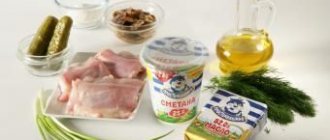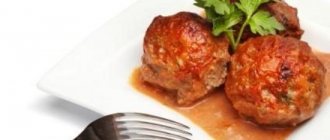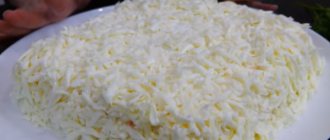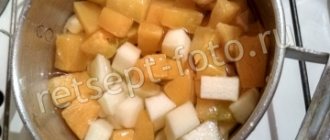Tiramisu cookies - classic Savoiardi recipe
When prepared correctly, this recipe produces incredibly tender, fragile tiramisu cookies.
From the listed quantity of products, two baking sheets with cookies are obtained:
- 3 eggs;
- 100 grams of fine sugar (can be replaced with powder);
- 75 grams of wheat flour;
- a couple of spoons of sugar for sprinkling;
- a pinch of salt;
- ½ tsp. lemon juice, maybe a little more.
First, prepare the foam. It is better to use a mixer - this will speed up the process. At the beginning of mixing, the speed should be at its lowest. When the protein mass has whipped to a stiff, stable foam that holds on the whisk, add sugar and speed up the beating a little. The result should be a very dense foam structure.
Next will be the yolks: you need to beat them first yourself, then add sugar or powder little by little. Then pour them into the whites, but do not mix them with a blender, otherwise the protein peaks will settle. Mix gently with a silicone spatula or spoon to distribute the yolks more or less evenly.
At this stage, we begin to add sifted flour in small portions and mix lightly with a spatula so as not to precipitate the splendor of the resulting mass.
Using a pastry bag, place the dough on a baking sheet and bake for 10 minutes in a preheated oven at 180 degrees. Let cool.
Cookies can be eaten with tea as an independent dessert or used to make more complex cakes and pastries.
On a note. In the classic Tiramisu recipe, the Savoyardi recipe is used to prepare the base - ordinary sponge dough, prepared so that it is slightly overdried and very light, porous.
Preparation:
Protein cream
To prepare a no-bake cake, break the eggs into a mixer bowl, add granulated sugar and beat until very fluffy and airy. If you have doubts about the mixer, you can separate the yolks from the whites.
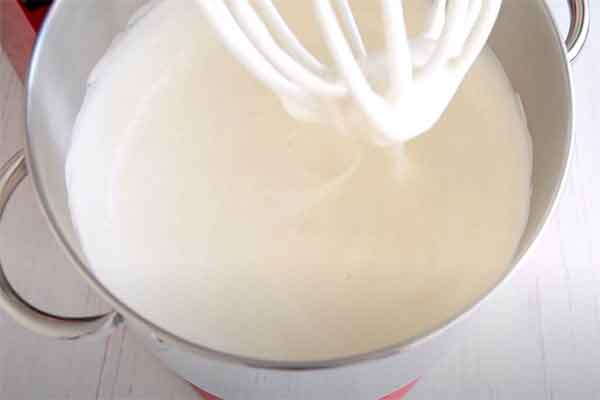
Then, separately, beat the whites without sugar into a fluffy, dense foam. Then gradually add half the sugar and continue beating until glossy.
The remaining sugar is added to the yolks and beaten at maximum speed until almost white. Next, carefully combine the two masses and mix with a spoon or silicone spatula.
Mascarpone cheese and cream cream
The next step is to transfer mascarpone cream cheese into cold cream. The cheese should also be cold. Turn on the mixer, mix at low speed to begin with, then gradually increase the speed to medium.
Since the cheese and cream are fatty, they can be easily overbeaten. Therefore, you should not set the speed to maximum. It is necessary to ensure that the products combine into a homogeneous mass and the structure of the cream acquires a fluffy state.

The final stage of preparing the cream
Next, the cream is added in small portions to the eggs, mixed with a silicone spatula or spoon until smooth. The cream should be mixed carefully so as not to disturb the delicate and airy consistency of the products. This was the most difficult part of making Tiramisu.
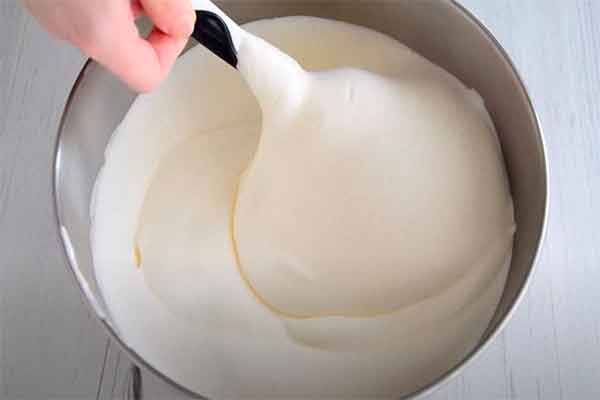
Assembling the cake
If you wish, you can add alcohol to the cooled espresso - rum, cognac, wine or some kind of liqueur. Savoiardi cookies are literally dipped into coffee for a second and placed on the bottom of the mold.
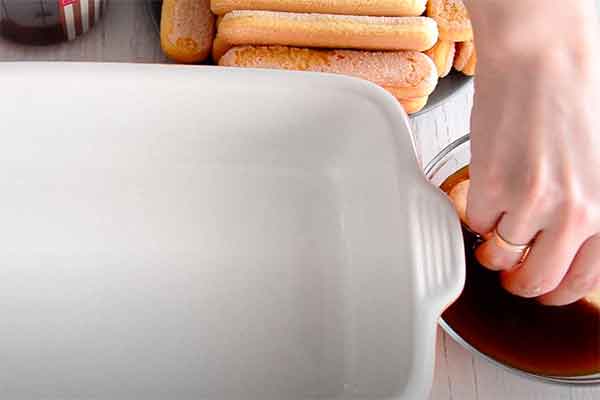
Then fill with cream and distribute evenly throughout the entire volume of the mold. After which Savoyardi again, thus alternating layers, assembling the Italian dessert.
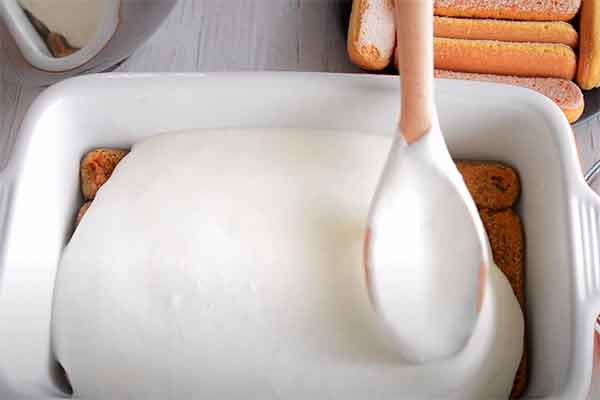
The cake is placed in the refrigerator for several hours, or overnight. Before serving, sprinkle the cake with a generous portion of unsweetened cocoa powder.
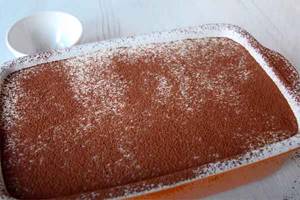
If there is cream and cookies left, you can prepare Tiramisu in glasses or glasses.
Recipe from Yulia Vysotskaya

- 5 eggs;
- powdered sugar;
- ½ powdered sugar;
- 0.5 kg mascarpone;
- a pinch of salt;
- coffee;
- a couple of spoons of cognac.
Carefully separate the whites and yolks. We carefully make sure that the yolk does not get into the white, otherwise it will not be possible to beat thick peaks. Leave the whites in the refrigerator for now - they whip better when cold.
Meanwhile, beat the yolk with powdered sugar into a thick mass until smooth. Next, add the mascarpone and mix gently.
Beat the whites with salt, add to the cheese and egg mixture and mix gently.
Prepare the base. Place pre-prepared sponge cake or Savoiardi cookies (according to the previous recipe) on the bottom of the mold. Brew strong coffee, total volume approximately 200 g. Add cognac to it for soaking. Use a spoon to gently soak the base. Pour the cream mixture on top and place in the refrigerator to harden.
Before serving, you can pour chocolate topping or sprinkle with nut crumbs.
On a note. Cognac can be replaced with another alcoholic drink - brandy, rum, aromatic liqueur (amaretto).
Don't think about safety
Never make tiramisu using raw egg yolks. Pasteurized yolks can be purchased at any supermarket, or you can pasteurize them at home by creating a simple syrup using sugar and a few tablespoons of water, brought to a temperature of about 121°C.
Eggs can carry salmonella bacteria. How to bring the syrup to 121 °C? If you don't have a kitchen thermometer, make sure the sugar boils with water to form large, sticky bubbles.
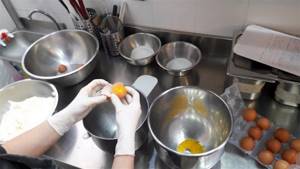
How to replace savoiardi cookies in tiramisu?
Novice cooks often use quick recipes, which significantly speed up the preparation of a dish.
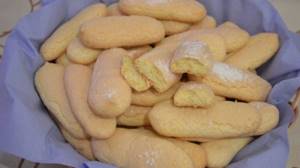
We offer options for replacing classic tiramisu cookies:
- Savoyardi cookies can be replaced with ordinary lady fingers. They are similar to classic cookies, but more shortbread. Therefore, during the preparation of dessert, it must be thoroughly soaked in coffee and liqueur impregnation.
- Also suitable for the base are butter or regular cookies for children.
- It is worth noting the most popular analogue for the base of Tiramisu in our area - a simple sponge cake. It is perfectly soaked, and the dessert turns out soft and tender.
All these options are quite suitable, but do not forget - the real taste will only be achieved when using classic Savoyardi cookies.
On a note. The base must be soaked. The dessert can be prepared in portions, in separate cups. Very convenient for get-togethers with guests - everyone will find it convenient to take dessert served in this form.
Tiramisu made from cottage cheese and cookies at home
A quick recipe. Perhaps it won’t be suitable for a big holiday, by the way, but for a get-together with girlfriends or a family tea party, it’s just what you need!
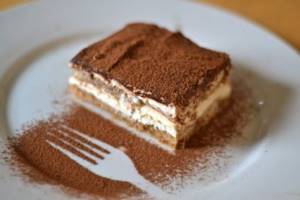
The recipe for tiramisu from cottage cheese and cookies has an extremely simple combination of products:
- packaging of shortbread cookies;
- 200 g low-fat cottage cheese;
- 100 grams of sour cream;
- 50 grams of sugar;
- a pinch of vanillin;
- brewed coffee (or instant coffee drink);
- cocoa.
Brew a small cup of coffee in advance.
Let's prepare cream for dessert from cottage cheese, sour cream, sugar and vanillin. Place everything in a deep container and whisk to form a homogeneous cream. You can use a blender - this will speed up the preparation significantly.
Place a layer of cookies on a flat dish, dipping them in the coffee drink. Lay out the next layer of cream, then repeat the layer of cookies and again - cream, until the products run out. The last layer is cream. Sprinkle cocoa on top.
Place the dessert in the refrigerator for a couple of hours so that the cream hardens. We set the table.
On a note. The coffee is prepared very strong, without sugar. Alcoholic drinks that enrich the taste with a piquant aroma are added if desired.
Tiramisu
Until recently, it was believed that tiramisu appeared in the Beccherie restaurant (city of Treviso, Veneto region) in 1970. This is true. But in the neighboring region of Friuli - in the town of Pieris not far from Trieste - chef Mario Cosolo treated his guests to the cold dessert “Coppa Vetturino Tirimezu” already in 1940-1950. Norma Pielli, his colleague from the Hotel Roma (Tolmezzo, Friuli region), served a dessert of Savoyardi biscuits, coffee and mascarpone cream in 1959 (there is evidence of this). What about the Venetians? They certainly have the credit for bringing the dish to the international stage: it was thanks to the restaurant “Ai do forni” in the capital of Veneto that tiramisu gained worldwide fame.
One of the common versions is that the famous dessert was invented in a brothel - such as in the film Ladies and Gentlemen by Pietro Germi, filmed in Treviso in 1965. Some even name the specific street where that same establishment was supposedly located - Calle dei Dal Oro. According to this version, after World War II, the owner of a brothel offered her clients a treat to boost their “morale”—after all, the literal phrase “tirami sù” means “lift me up.” To do this, she used what little she had in the pantry: eggs, coffee, sugar, marsala and biscuits. At least, this is how Zenone Giuliato described it in his book “The Stories of Zeno.” And although concrete evidence of this version has not survived, it is impossible not to mention it.
The predecessor of this dessert can be considered “English soup”, popular in Ferrara and Reggio Emilia in the 18th century. Its recipe was described in 1834 by Vincenzo Agnoletti, court chef of the Duchy of Parma. Then, in 1891, the dessert “Dolce Torino” appeared from the famous gourmet Pellegrino Artusi. And the bravest trace tiramisu back to 1569, which dates back to the first mention of the English dessert “trifle,” which was a success among thrifty housewives. In English, “trifle” meant “joke” - a way of serving a cold dessert with whipped cream.
Lombardy also claims the right to call tiramisu its dessert. For example, the first mention of mascarpone cheese, the main ingredient of the delicacy, is associated with the city of Lodi, not far from Milan. For Christmas, they prepared a delicacy based on mascarpone and panettone cake sprinkled with cinnamon. Mascarpone is still produced here according to ancient recipes, but it began to be widely exported in the 70s of the 20th century from the city of Polengi.
You can't make tiramisu without Savoyardi. These biscuits, also called ladyfingers, originated at the Savoyard court in Turin. King Victor Emmanuel II's cook, Giovanni Vialardi, dubbed them "Savoy biscuits" in his 1854 treatise. Thanks to their porous structure, they perfectly absorb cream and are suitable for cold desserts. So tiramisu can also be considered a Piedmontese dish - however, in this region no one needs to be convinced.
Today the word "tiramisu" exists in 23 languages. Many terms of Italian cuisine have become international: pasta, pizza, espresso, spaghetti. In China, “tiramisu” is the most frequently found Italian word in search queries.
Did you know that pasta day is celebrated on October 25, milk day on June 1, and until recently tiramisu did not have its own holiday? Now this annoying misunderstanding has been eliminated: thanks to Eataly, Tiramisu Day is celebrated on March 21 all over the world, from Trieste to New York. And what better date for this holiday than the first day of spring in Italy?
How to cook tiramisu?
Photo: Shutterstock.com
- 6 eggs - 140 g sugar - 500 g mascarpone - 700 g coffee - 30 g grated bitter cocoa - 30 g milk chocolate flakes - 400 g Savoyardi cookies
- To begin, separate the whites from the yolks, mix the yolks with half the sugar and beat with the whisk of a mixer until light and fluffy.
- Add mascarpone to the yolk mixture. Now it’s time for the whites: they also need to be beaten with a mixer, and when they are half whipped, gradually add the remaining sugar to them and beat until very thick foam. Now add a mixture of whipped yolks, sugar and mascarpone to this foam. You need to mix very carefully, from bottom to top, making sure that the whites remain whipped.
- The cream is ready. Spread a thin layer of it on the bottom of individual bowls or large pans if you are not preparing individual portions. Soak the Savoyardi in coffee, but do not let them get too wet. Then place them on top of the cream. Place a layer of cream on top of the Savoyardi and smooth it out. Then another layer of Savoyardi. Sprinkle them with cocoa powder; if desired, the surface can be decorated with chocolate chips. Note: if the first layer of savoiardi was laid out horizontally, then in the second layer it is better to lay them out edgewise. Place the cake in the refrigerator for a few hours to firm up and... bon appetit!




